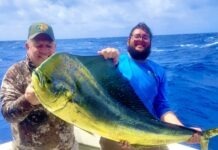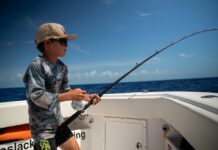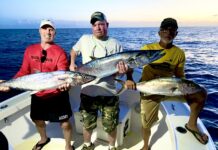
The offshore mahi bite has slowly but surely been getting better over the past couple of weeks. We have been seeing a lot of small, undersized fish inshore in depths of 600 feet, and having better luck with bigger, quality fish further offshore in water 1,000 feet or deeper.
My typical spread when I am trolling for mahi is a rigged ballyhoo in each outrigger and two three-inch artificial baits on the flatlines. So far this season, I have found that the majority of fish have been eating the smaller bait that mimic the flying fish we commonly find in the stomachs of our catch at the filet table.
Fishing on the reef has not been easy lately. A combination of irregular water sediment levels and uncommon currents from a variety of directions switching daily has made fishing difficult, but not impossible. The past couple of weeks have made anglers sharpen their skills and employ lighter-tackle tactics. Yellowtail snapper and black grouper have been our target species as we patiently wait for the mangrove snapper spawn to begin in mid-July.
When it comes to catching yellowtail snapper, the first order of business is to set up your chum slick. Positioned on the reef in 40 to 90 feet of water, place your boat up current from the area you would like to fish. Start by placing your frozen block of chum in your large mesh chum hoop. I suggest starting off with at least two seven-pound blocks of chum in the water, or you can use a 25-pound block, which will last you much longer and is more cost effective. Many fishermen also add oats to their chum slicks to help raise the fish off the reef, leading to a lower chance of getting caught on the bottom.
When targeting yellowtail snapper, I prefer to use a seven-foot light action rod paired with a 4500 series reel that is spooled with 12-pound monofilament. Attached to your main line, I start off with a 20-foot section of 12-pound fluorocarbon leader and double the line through the eye of the hook. Weighted jigs such as yellow tail candy can be used and are effective, but I prefer to use a plain size 6 hook with a small piece of bait, so it drifts back with the chum. Peeled shrimp is the preferred bait to catch these snapper. According to FWC regulations, yellowtail snapper must be a minimum of 12 inches total length, measured from the front of the mouth to the tip of the tail. I prefer to release any fish smaller than 14 inches since there is not much of a filet on a smaller yellowtail snapper. The limit on this abundant fish is 10 per person.
Yellowtail snapper is delicious when fried, broiled, baked, grilled, or sauteed and can be found in most local restaurants as fresh catch year-round. My personal favorite way to munch these fish is fried in a coconut batter dipped in a sweet Thai chili sauce.
Get out there and get tight!






















